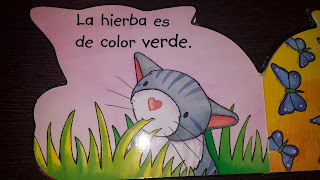SONG : Let's Go To the Zoo.
LYRIC OF THE SONG:
“Let´s go to the zoo”
Let's go to the zoo, zoo, zoo
Me and you to the zoo
Let's go to the zoo, zoo, zoo
Let's go to the zoo
Alligator, alligator
Eat, eat, eat
Rabbit, Rabbit
Hop, hop, hop
Penguin, penguin
Walk, walk, walk
Elephant, elephant
Stomp, stomp, stomp
Monkey, monkey
Scratch, scratch, scratch
Tiger, tiger
Run
- ACTIVITY: “ Let´s go to the zoo ” song
- WHEN AND WHERE: After the assembly, in the middle of the class because this aactivity is good for the children to have activity early in the morning.
- OBJECTIVES:The children learn the names of the animals in English and the correct pronunciation. They sing a song, work on the concentration, the memory and they play games in groups.
- PROCEDURE:
- The teacher says the animal´s names while she shows the mask with the faces of the animals and she puts the mask on her face.
- The teacher sings the song one time and then she sings it again with the children And she puts the mask on her face for the children TO identify
- The game. The teacher has a lucky rulet with the names of the player and one dice with the animals faces ( Alligátor, Rabbit, Penguin, Elephant, Monkey and Tiger ). The teacher explains the children that they have to sit down in a circle. Then the teacher starts to play the game in the middle of the circle. She rolls the dice and the face that is on the top of the dice is the name of the animal the children have to learn and then she chooses the mask with this animal face and puts it on her face . Then the teacher turns the lucky roulette choose the next player.
- MATERIAL: - A dice with 6 animal´s faces and name 6 mask whith animal´s faces A lucky roulette with the name of the children.
- AGE: 2 - 6
- VARIATIONS: The same game but each month we change the animals ( more animals from the zoo, from the farm, from the sea, from the jungle... And we also play learning the colours because each face in the ha a diferent colour
- Other variation is doing the movement of the animals when the teacher ask “What does tiger do?”.























